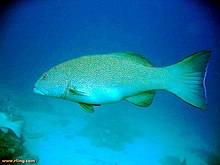Coral trout
| Coral trout | |
|---|---|
 |
|
| Scientific classification | |
| Kingdom: | Animalia |
| Phylum: | Chordata |
| Class: | Actinopterygii |
| Order: | Perciformes |
| Family: | Serranidae |
| Genus: | Plectropomus |
| Species: | P. leopardus |
| Binomial name | |
|
Plectropomus leopardus (Lacepède, 1802) |
|
The coral trout, leopard coral grouper, or leopard coral trout (Plectropomus leopardus) is a species of fish in the Serranidae family. Native to the western Pacific Ocean, its natural habitat includes open seas and coral reefs. Coral trout are piscivorous; juveniles mostly eat crustaceans, especially prawns, and adults feed upon a variety of reef fish, particularly damselfish.
Coral trout are the favourite target fish for all sectors of the fishery because they are a good food fish and command high market prices locally and overseas. The total commercial catch of coral trout was reported at over 1500 tonnes in 1998.
Initially described by French naturalist Bernard Germain de Lacépède in 1802, the Coral trout belongs to a family of fish known as the Serranidae. This family includes groupers and coral cod (not related to true cod), which are all characterised by having three spines on the gill cover and a large mouth lined with more than one row of sharp teeth.
The Coral trout is found in the waters around American Samoa, Australia, Brunei, Cocos (Keeling) Islands, Fiji, Hong Kong, Indonesia, Japan, Malaysia, Micronesia, New Caledonia, Northern Mariana Islands, Palau, Papua New Guinea, the Philippines, Samoa, Singapore, Solomon Islands, Taiwan, Thailand, Vietnam, Saudi Arabia, and Egypt . Its natural habitat includes open seas and coral reefs. Studies suggest that coral trout move around considerably within a single reef, though often no further than 500 meters (1,600 ft) from it. Movement between neighbouring reefs does not occur to a large extent; however, there have been a few cases where fish have moved from one reef to another. Much of this movement may be the result of fish moving towards or away from spawning sites.
...
Wikipedia

